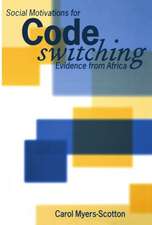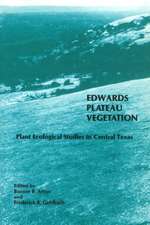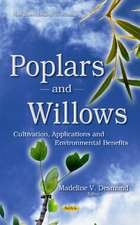Protocols in Lichenology: Culturing, Biochemistry, Ecophysiology and Use in Biomonitoring: Springer Lab Manuals
Editat de Ilse Kranner, Richard Beckett, Ajit Varmaen Limba Engleză Paperback – 10 oct 2001
Din seria Springer Lab Manuals
-
 Preț: 385.84 lei
Preț: 385.84 lei -
 Preț: 362.59 lei
Preț: 362.59 lei - 18%
 Preț: 973.69 lei
Preț: 973.69 lei - 15%
 Preț: 695.85 lei
Preț: 695.85 lei - 18%
 Preț: 997.40 lei
Preț: 997.40 lei -
 Preț: 385.84 lei
Preț: 385.84 lei -
 Preț: 382.18 lei
Preț: 382.18 lei - 24%
 Preț: 1045.08 lei
Preț: 1045.08 lei - 15%
 Preț: 641.20 lei
Preț: 641.20 lei - 18%
 Preț: 939.33 lei
Preț: 939.33 lei -
 Preț: 381.43 lei
Preț: 381.43 lei - 15%
 Preț: 637.59 lei
Preț: 637.59 lei - 15%
 Preț: 639.25 lei
Preț: 639.25 lei -
 Preț: 376.68 lei
Preț: 376.68 lei - 18%
 Preț: 1822.40 lei
Preț: 1822.40 lei - 18%
 Preț: 953.82 lei
Preț: 953.82 lei - 15%
 Preț: 645.14 lei
Preț: 645.14 lei - 15%
 Preț: 689.93 lei
Preț: 689.93 lei - 23%
 Preț: 821.58 lei
Preț: 821.58 lei - 19%
 Preț: 588.70 lei
Preț: 588.70 lei - 5%
 Preț: 727.44 lei
Preț: 727.44 lei - 18%
 Preț: 1225.31 lei
Preț: 1225.31 lei - 15%
 Preț: 657.39 lei
Preț: 657.39 lei - 18%
 Preț: 949.73 lei
Preț: 949.73 lei -
 Preț: 386.99 lei
Preț: 386.99 lei - 15%
 Preț: 657.25 lei
Preț: 657.25 lei - 19%
 Preț: 555.62 lei
Preț: 555.62 lei -
 Preț: 380.63 lei
Preț: 380.63 lei - 18%
 Preț: 1226.11 lei
Preț: 1226.11 lei - 15%
 Preț: 649.22 lei
Preț: 649.22 lei - 15%
 Preț: 632.55 lei
Preț: 632.55 lei - 19%
 Preț: 584.76 lei
Preț: 584.76 lei - 15%
 Preț: 639.41 lei
Preț: 639.41 lei - 15%
 Preț: 644.82 lei
Preț: 644.82 lei -
 Preț: 390.25 lei
Preț: 390.25 lei - 18%
 Preț: 781.31 lei
Preț: 781.31 lei - 15%
 Preț: 644.63 lei
Preț: 644.63 lei -
 Preț: 382.36 lei
Preț: 382.36 lei -
 Preț: 363.12 lei
Preț: 363.12 lei - 18%
 Preț: 961.23 lei
Preț: 961.23 lei -
 Preț: 416.29 lei
Preț: 416.29 lei - 18%
 Preț: 783.35 lei
Preț: 783.35 lei - 18%
 Preț: 791.88 lei
Preț: 791.88 lei - 15%
 Preț: 675.22 lei
Preț: 675.22 lei -
 Preț: 381.43 lei
Preț: 381.43 lei
Preț: 1311.54 lei
Preț vechi: 1703.31 lei
-23% Nou
Puncte Express: 1967
Preț estimativ în valută:
250.96€ • 262.73$ • 207.65£
250.96€ • 262.73$ • 207.65£
Carte tipărită la comandă
Livrare economică 02-08 aprilie
Preluare comenzi: 021 569.72.76
Specificații
ISBN-13: 9783540411390
ISBN-10: 3540411399
Pagini: 600
Ilustrații: XVI, 580 p. 41 illus., 1 illus. in color.
Dimensiuni: 193 x 242 x 32 mm
Ediția:Softcover reprint of the original 1st ed. 2002
Editura: Springer Berlin, Heidelberg
Colecția Springer
Seria Springer Lab Manuals
Locul publicării:Berlin, Heidelberg, Germany
ISBN-10: 3540411399
Pagini: 600
Ilustrații: XVI, 580 p. 41 illus., 1 illus. in color.
Dimensiuni: 193 x 242 x 32 mm
Ediția:Softcover reprint of the original 1st ed. 2002
Editura: Springer Berlin, Heidelberg
Colecția Springer
Seria Springer Lab Manuals
Locul publicării:Berlin, Heidelberg, Germany
Public țintă
Professional/practitionerCuprins
Culture and Cultivation.- 1 Isolation and Culture of Lichen Photobionts and Mycobionts.- 2 Culture of Thallus Fragments and Redifferentiation of Lichens.- 3 Resynthesis of Photosymbiodemes.- 4 Protoplast Isolation from Lichen Mycobionts.- 5 Differentiation Processes in Lichens—in Vivo Cultivation and Transplantation Methods.- 6 Isolation and Culture of Lichenicolous Fungi.- Ultrastructure.- 7 Preparative Techniques for Transmission Electron Microscopy and Confocal Laser Scanning Microscopy of Lichens.- 8 Preparative Techniques for Low Temperature Scanning Electron Microscopy of Lichens.- Physiology and Ecophysiology.- 9 Measurement of Chlorophyll Fluorescence in Lichens.- 10 Characterising Photosynthesis and Respiration in Freshly Isolated or Cultured Lichen Photobionts.- 11 Analysis of Ethylene and ACC in Lichens.- 12 Measuring Activities of the Enzymes Superoxide Dismutase and Glutathione Reductase in Lichens.- 13 Studying the Effects of Elevated Concentrations of Carbon Dioxide on Lichens Using Open Top Chambers.- 14 In situ Measurements of the Water Content of Lichens.- 15 Determination of the Parameters of Liehen Water Relations.- 16 Measurement of Lichen Growth.- Lichen Compounds.- 17 Analysis of Phenolic Products in Lichens for Identification and Taxonomy.- 18 Investigating the Production of Secondary Compounds in Cultured Lichen Mycobionts.- 19 Analysing Lichen Enzymes by Isoelectricfocussing.- 20 Analysis of Lipids in Lichens.- 21 Measuring Ergosterol and Chitin in Lichens.- 22 Analysis of Chlorophylls, Carotenoids, and Tocopherols in Lichens.- Nucleic acids.- 23 Isolation of Nucleic Acids from Lichens.- 24 PCR Techniques and Automated Sequencing in Lichens.- 25 RAPD-PCR of Lichens.- Bioindication and Biomonitoring.- 26 Biomonitoring Radionuclide Depositionwith Lichens.- 27 Biomonitoring Heavy Metal Pollution with Lichens.- 28 Bioindication of Sulphur Dioxide Pollution with Lichens.- Biodiversity and Information Systems.- 29 Management of a Lichen Herbarium.- 30 Documentation of Lichens by Macrophotography.- 31 Computer-Aided Identification Systems for Biology, with Particular Reference to Lichens.- 32 On-line Documentation of Lichen Biodiversity.
Recenzii
From the reviews:
"The aim of the reviewed book is to facilitate the experimental study of lichens by providing detail protocols of analytical methods well-tested in specialised laboratories. … Each chapter of the book is accompanied by a list of important references. An attached glossary of morphological terms and subject index are also helpful for a potential user. The reviewed book represents an invaluable and unique collection of the most recent methodical approaches to the experimental study of lichens … ." (J. Gloser, Photosynthetica, Vol. 40 (3), 2002)
"This compendium of techniques for handling lichens experimentally is a useful reference for both research and teaching. … this volume also includes many helpful little tricks that do not usually appear in published research papers, as well as designs for practical devices … . The book ends with an interesting collection of contributions related to the handling of specimens and data, along with a chapter by V. Wirth on lichen photography. This volume is really a functional working manual." (Dianne Fahselt, The Lichenologist, Vol. 34 (3), 2002)
"This practical guide pulls together a corpus of useful methodological material from a wide variety of sources. Thirty-two chapters, contributed by specialists in their fields, provide detailed descriptions of or more protocols necessary for the experimental lichenologist. … the volume under review contains a wealth of practical advice (in terms of materials, procedures and trouble-shooting, often supported by extensive lists of references), some of which will have wider relevance beyond the lichenologist’s requirements." (The Naturalist, 2002)
"This is a welcome addition to the series because lichenological methods are seldom documented in texts on mycology, phycology or plant science. Methods described are wide ranging, most are lab procedures, but some are field-based … . Instructions are more explicit than is usually ina research paper, and include useful tips, warnings of potential pitfalls, and sections on troubleshooting. … this pleasingly produced volume is a creditable starting point. It is essential buying for lichenologists and deserves a place in institutional libraries … ." (Peter Crittenden, Microbiology Today, Vol. 29, August, 2002)
"The aim of the reviewed book is to facilitate the experimental study of lichens by providing detail protocols of analytical methods well-tested in specialised laboratories. … Each chapter of the book is accompanied by a list of important references. An attached glossary of morphological terms and subject index are also helpful for a potential user. The reviewed book represents an invaluable and unique collection of the most recent methodical approaches to the experimental study of lichens … ." (J. Gloser, Photosynthetica, Vol. 40 (3), 2002)
"This compendium of techniques for handling lichens experimentally is a useful reference for both research and teaching. … this volume also includes many helpful little tricks that do not usually appear in published research papers, as well as designs for practical devices … . The book ends with an interesting collection of contributions related to the handling of specimens and data, along with a chapter by V. Wirth on lichen photography. This volume is really a functional working manual." (Dianne Fahselt, The Lichenologist, Vol. 34 (3), 2002)
"This practical guide pulls together a corpus of useful methodological material from a wide variety of sources. Thirty-two chapters, contributed by specialists in their fields, provide detailed descriptions of or more protocols necessary for the experimental lichenologist. … the volume under review contains a wealth of practical advice (in terms of materials, procedures and trouble-shooting, often supported by extensive lists of references), some of which will have wider relevance beyond the lichenologist’s requirements." (The Naturalist, 2002)
"This is a welcome addition to the series because lichenological methods are seldom documented in texts on mycology, phycology or plant science. Methods described are wide ranging, most are lab procedures, but some are field-based … . Instructions are more explicit than is usually ina research paper, and include useful tips, warnings of potential pitfalls, and sections on troubleshooting. … this pleasingly produced volume is a creditable starting point. It is essential buying for lichenologists and deserves a place in institutional libraries … ." (Peter Crittenden, Microbiology Today, Vol. 29, August, 2002)
Textul de pe ultima copertă
As an intricate association between a fungus and one or more green algae or cyanobacteria, lichens are one of the most successful examples of symbiosis. These fascinating organisms survive extreme desiccation and temperatures. They are adapted to a great variety of habitats, from coastal fog zones of deserts to intertidal zones, from plant leaves in tropical rain forests to the glacial moraines of the Himalayas, and they are dominant components of communities in circumpolar ecosystems. Possibly, because of their tendency to grow in nutrient-poor habitats, lichens are extremely efficient accumulators of atmospherically deposited pollutants, and are therefore widely used to monitor environmental pollution. The wide range of secondary products only found in lichens show pharmaceutically interesting fungicidal, antibacterial and antiviral properties. Lichens are extremely difficult to culture, grow very slowly, and their secondary metabolites very often complicate the analyses of other compounds. As a result, they require special techniques. This manual provides well-tested protocols, including tissue culture protocols and methods for studying lichen ultrastructure, (eco)physiology, primary and secondary compounds, and nucleic acids. Protocols for using lichens to monitor environmental pollution and to document lichen biodiversity are also provided. Special terms used in lichenology are explained in a glossary.
Caracteristici
First book presenting well-tested protocols appropriate to study lichens, organisms which are extremly difficult to culture Detailed step-by-step protocols, including troubleshooting sections and many hints and comments from the authors A glossary explains the special terms used in lichenology Includes supplementary material: sn.pub/extras











